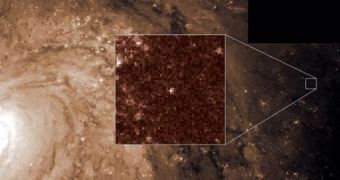Unknowingly, when looking at certain stars with special features, we might be witnessing message transmission attempts from other civilizations, researchers claim.
Since mankind first came up with the idea that space might be too big just for us or that maybe God hasn't wasted all the universe just on terrestrials, people have been trying to put a finger on what exactly an alien message would consist of. Currently, SETI's (Search for Extra-Terrestrial Intelligence program) still timid attempts of trying to understand that only limit to deciphering particular radio wavelengths coming from space. Other approaches consisted in the search for physical artifacts created by our universe's co-inhabitants.
But let's be serious, would we really be able to understand an alien message if we saw it? What if the other hypothetical civilizations we're trying to establish contact with don't know what radio frequency is or are way past that stage? Perhaps they use totally different techniques for this purpose. In this regard, University of Hawaii's neutrino physicists came up with a new perspective: aliens send us messages by manipulating stars. Professor John Learned suggested that such cosmic bodies used for this "galactic Internet" might be the unique Cepheids stars, which may have drawn the attention of other civilizations as well.
Because of the way they brighten and dim at regular intervals, allowing astrophysicists to measure the distance to them and a wide range of other features, the researchers deduced that other civilizations may be interested in them and perhaps even use them in order to make their presence known. The Cepheids dim when the ionized helium gathers in their atmosphere and start to brighten when the atmosphere deionizes and expands. This cycle could be altered by a more advanced race by sending a high-energy neutrino beam in order to heat a Cepheid's core "just as an electric pulse to the heart can make it skip a beat," explains Learned. Seth Shostak, senior astronomer at SETI Institute in Mountain View, California agrees: "It's a great idea, reminiscent of an old Russian idea about bouncing high-energy radiation off the 100 or 200 real supergiant stars in the galaxy to generate anomalous radiation as signals others could see."
But Learned also admits that the process would be extremely slow, since a Cepheid with a cycle of about one day would only transmit approximately 180 bits each year, a transmission that would use a millionth of the star's energy. "A millionth of a star's output is a heck of a lot of energy," adds Shostak.
Controversial to this theory, one could ask legitimate questions like "How would aliens identify, from the myriads of possibilities, that a possible civilization is located in the viewing range of Cepheids? And if they're so advanced, why haven't they come in person?" Meanwhile, scientists have 100 years’ worth of data to analyze in search for the validity of the hypothesis.

 14 DAY TRIAL //
14 DAY TRIAL //